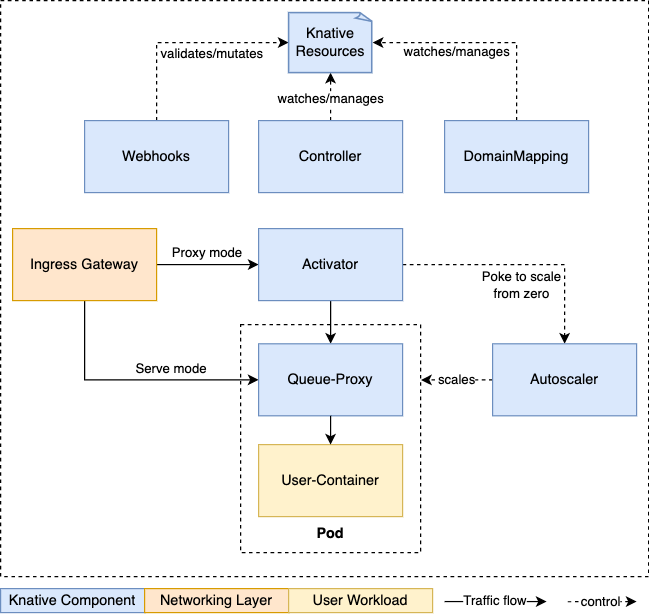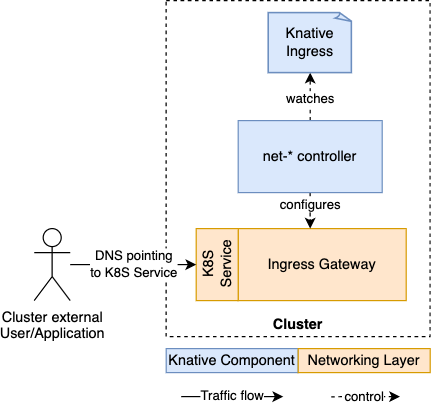Knative Serving Architecture¶
Knative Serving consists of several components forming the backbone of the Serverless Platform. This page explains the high-level architecture of Knative Serving. Please also refer to the Knative Serving Overview and the Request Flow for additional information.
Diagram¶

Components¶
| Component | Responsibilities |
|---|---|
| Activator | The activator is part of the data-plane. It is responsible to queue incoming requests (if a Knative Service is scaled-to-zero). It communicates with the autoscaler to bring scaled-to-zero Services back up and forward the queued requests. Activator can also act as a request buffer to handle traffic bursts. Additional details can be found here. |
| Autoscaler | The autoscaler is responsible to scale the Knative Services based on configuration, metrics and incoming requests. |
| Controller | The controller manages the state of Knative resources within the cluster. It watches several objects, manages the lifecycle of dependent resources, and updates the resource state. |
| Queue-Proxy | The Queue-Proxy is a sidecar container in the Knative Service's Pod. It is responsible to collect metrics and enforcing the desired concurrency when forwarding requests to the user's container. It can also act as a queue if necessary, similar to the Activator. |
| Webhooks | Knative Serving has several webhooks responsible to validate and mutate Knative Resources. |
Networking Layer and Ingress¶
Note
Ingress in this case, does not refer to the Kubernetes Ingress Resource. It refers to the concept of exposing external access to a resource on the cluster.
Knative Serving depends on a Networking Layer that fulfils the Knative Networking Specification.
For this, Knative Serving defines an internal KIngress resource, which acts as an abstraction for different multiple pluggable networking layers. Currently, three networking layers are available and supported by the community:
Traffic flow and DNS¶
Note
There are fine differences between the different networking layers, the following section describes the general concept. Also, there are multiple ways to expose your Ingress Gateway and configure DNS. Please refer the installation documentation for more information.

- Each networking layer has a controller that is responsible to watch the
KIngressresources and configure theIngress Gatewayaccordingly. It will also report backstatusinformation through this resource. - The
Ingress Gatewayis used to route requests to theactivatoror directly to a Knative Service Pod, depending on the mode (proxy/serve, see here for more details). TheIngress Gatewayis handling requests from inside the cluster and from outside the cluster. - For the
Ingress Gatewayto be reachable outside the cluster, it must be exposed using a Kubernetes Service oftype: LoadBalancerortype: NodePort. The community supported networking layers include this as part of the installation. Then DNS is configured to point to theIPorNameof theIngress Gateway
Note
Please note, if you do use/set DNS, you should also set the same domain for Knative.
Autoscaling¶
You can find more detailed information on our autoscaling mechanism here.